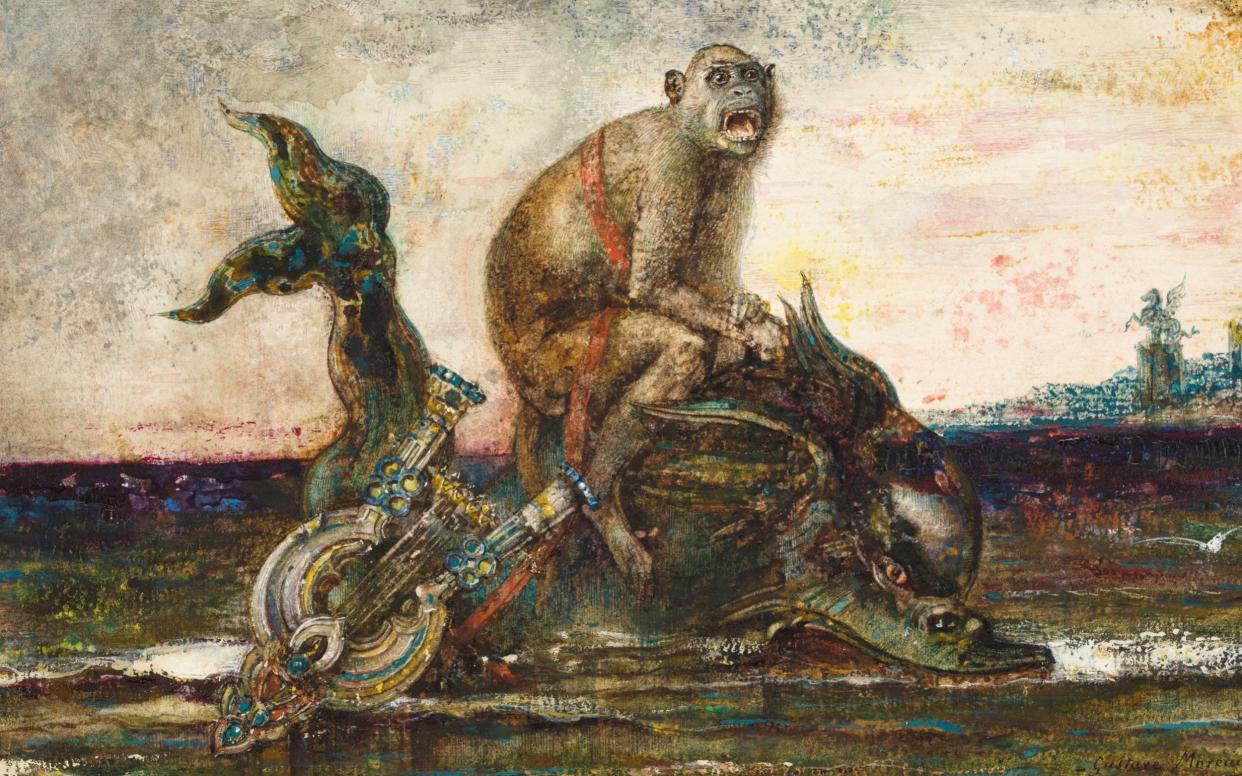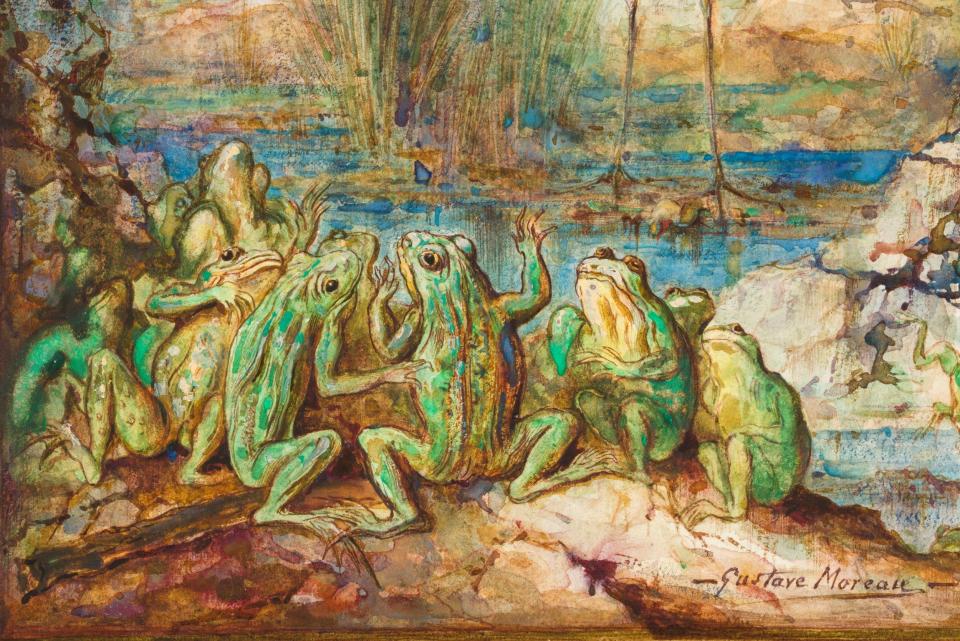Gustave Moreau: The Fables, Waddesdon, review: like a jeweller ‘drunk on colour’

In the sea, once upon a time, o best beloved, there was a dolphin. And upon his back he bore a survivor from a shipwreck, believing him to be a man. Except he wasn’t a man, but a mendacious, boastful monkey. And when this deceitful chatterbox eventually caught himself out, the dolphin tossed him back to drown, and set off to find someone worth rescuing.
This disturbing tale is one of a myriad moralising fables collated and composed, over many years and in multiple volumes, by the 17th-century French poet Jean de La Fontaine. Popular in his homeland, La Fontaine’s Fables have been illustrated across the centuries by various artists – including the solitary 19th-century Symbolist Gustave Moreau, who between 1879 and 1885 produced 64 resplendent watercolours for a collector in Marseilles.
Unseen in public for more than a century and on loan, with one exception, from a Rothschild private collection, just over half of Moreau’s series (the rest disappeared during the Second World War) is now on display at Waddesdon Manor in Buckinghamshire. And Moreau’s take on “The Monkey and the Dolphin” is one of the darkest, and most memorable, of the lot.
Atop a stylised dolphin, a hunched, highly realistic monkey, eyes gleaming in sudden recognition of his fate, howls in fright. To prepare for the task of depicting La Fontaine’s talking animals, Moreau spent a lot of time at the zoo – and, here, he carefully picks out the monkey’s mouth so that we stare down the barrel of its maw, into a void. Francis Bacon, that master of existential screams, would have approved. Though the dolphin appears unnatural, even alien, the simian show-off on its back wins our sympathy. Poor little creature.
What an extraordinary show this is. Unless you have visited the atmospheric museum preserving his studio-house on the rue de la Rochefoucauld in Paris, Moreau may be something of an unknown quantity. The 35 astonishing watercolours at Waddesdon, though, reveal his breadth and originality, as well as the intensity of his vision.
Moreover, created at the height of the 19th-century French revival of the medium, they will confound, and delight, anyone familiar with watercolour painting in Britain.When they were first exhibited, during the 1880s, they bedazzled Moreau’s contemporaries: one compared him to a jeweller “drunk on colour”, seemingly grinding up rubies, sapphires, and emeralds to make his palette.
Though we know roughly the order in which they were created, the watercolours are hung by theme, in a single small room: a wall of mythological figures here, a cluster of animal pictures there. Many visitors will enjoy the narrative subject matter, some of it familiar from Aesop (“The Town Rat and the Country Rat”, “The Fox and the Grapes”), much not (“The Peasant of the Danube”).

I, though, couldn’t have cared less about the specifics of each fable, because I was too busy marvelling at Moreau’s invention. He never illustrates his material literally, but rather embellishes it with diverting details and a peculiar, aching mystery, so that each picture is a miniature world unto itself. One moment, we are looking at the Senate of ancient Rome; the next, an opulent Orientalist fantasy, reminding us that Matisse, who also turned to Orientalism, with his odalisques during the Twenties, was once Moreau’s pupil. There are quasi Dutch and Shakespearean scenes, radiant landscapes reminiscent of Turner, a sumptuous still life in the manner of Jan Davidsz. de Heem.
In one fabulous sheet, a gaggle of puffed-up green frogs, drawing upon studies of live specimens sent to Moreau by a taxidermist, jigs about in an uproar as a nearby crane snacks on one of their friends: its mutilated remnants are still dripping from the towering bird’s beak. In another, “The Head and the Tail of the Snake”, the story is almost irrelevant: Moreau’s true subject is the background’s semi-abstract chromatic cascade, like a display of fireworks, ostensibly evoking a glowing cavern.
Throughout, the artist’s technique is a surprise. His paint is often textured and rich, applied with a dry brush, and flecked with opaque body colour, as densely detailed as the decoration on a ceremonial sword. This contrasts with areas of translucent wash, so that sensual flesh shines like an apparition. In “Death and the Woodcutter”, the former is represented by a (literal) “femme fatale” rather than the usual skeleton lurking with a scythe.
When, in 1886, Moreau’s watercolours were exhibited in London, one critic suggested that he was “less the illustrator of the fable than of allegory, witchery and enchantment”. That’s spot on. Looking at these strange dream-worlds is like passing through a fairy-tale forest thick with magic and flickering, supernatural lights. What intoxicating vision will we encounter next? The only pity is that, because of Covid, Moreau’s preparatory drawings couldn’t be here, too.
From June 16 until Oct 17; info: waddesdon.org.uk 01296 820414